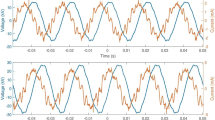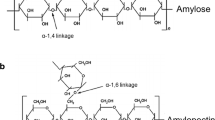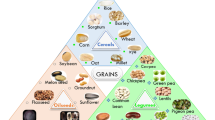Abstract
The effects of rice flour (50–56%, w/w) and gum Arabic (0–5%, w/w) on the physical, sensory and structural features of the fried dough strands were investigated. Up to 25.8% reduction in oil was possible by the incorporation of gum Arabic. The wide variations in failure force (13.8–25.3 N) and failure strain (11.0–28.6%) indicated the formation of snacks varying in texture from a soft-to-bite brittle product to a hard-to-eat less brittle sample. The snacks possessed a porous microstructure with air cells, pores and vacuoles; the cell walls were more than 100 μm in thickness. The textural parameters like failure force, failure energy and failure stress behaved in a similar manner in the principal component analysis biplot. High moisture content in the dough decreased the sensory acceptance of the fried snacks. The high desirability index of 0.9 could be achieved with a high level of rice flour (56%, w/w) while gum Arabic content was between 3.50 and 3.75% (w/w).




Similar content being viewed by others
References
Anton AA, Artfield SD (2008) Hydrocolloids in gluten-free breads: a review. Int J Food Sci Nutr 59:11–23
AOAC (1980) Official methods of analysis, 13th edn. Association of Official Analytical Chemists, Washington, pp 132–211
Bean MM, Nishita KD (1985) Rice flours for baking. In: Juliano BO (ed) Rice chemistry and technology, 2nd edn. AACC International, St. Paul, pp 539–556
Bhattacharya S (2012) Rheological characterization and modeling of rice flour dough: effect of parboiling time, moisture content and gum arabic. J Texture Stud 43:400–412
Bhattacharya S, Narasimha HV (2008) Effect of raw material characteristics on the properties of fried rice-blackgram dough. Int J Food Sci Nutr 59:502–511
Bhattacharya S, Bhattacharya S, Narasimha HV (2003) Effect of gum Arabic on the rheology of corn flour doughs and fried product quality. J Texture Stud 34:421–436
de la Hera E, Martinez M, Gomez M (2013) Influence of flour particle size on quality of gluten-free rice bread. LWT-Food Sci Technol 54:199–206
Garmakhany DA, Mirzaei HO, Maghsudlo Y, Kashaninejad M, Jafari SM (2014) Production of low fat french-fries with single and multi-layer hydrocolloid coatings. J Food Sci Technol 51:1334–1341
Guarda A, Rosell CM, Benedito C, Galotto MJ (2004) Different hydrocolloids as bread improvers and antistaling agents. Food Hydrocolloid 18:214–247
Izadi S, Ojagh SM, Rahmanifarah K, Shabanpour B, Sakhale BK (2015) Production of low-fat shrimps by using hydrocolloid coatings. J Food Sci Technol 52:6037–6042
Juliano BO, Sakurai J (1985) Miscellaneous rice products. In: Juliano BO (ed) Rice chemistry and technology, 2nd edn. AACC International, St. Paul, pp 569–618
Kapri A, Bhattacharya S (2008) Gelling behavior of rice flour dispersions at different concentrations of solids and time of heating. J Texture Stud 39:231–251
Lawless HT, Heymann H (1998) Data relationships and multivariate applications. In: Lawless HT, Heymann H (eds) Sensory evaluation of food: principles and practices. Chapman & Hall, New York, pp 585–601
Luh BS, Bhumiratana A (1980) Breakfast rice cereals and baby foods. In: Luh BS (ed) Rice: production and utilization. AVI Publishing, Westport, pp 622–649
Moghaddam TM, Parvar MB, Razavi SMA (2015) Effect of frying temperature and time on image characterizations of pellet snacks. J Food Sci Technol 52:2958–2965
O’Shea N, Arendt E, Gallagher E (2014) State of the art in gluten-free research. J Food Sci 79:R1067–1076
Pedreschi F, Enrione J (2015) Frying of foods. In: Bhattacharya S (ed) Conventional and advanced food processing technologies. Wiley, Chichester, pp 197–220
Ravi R, Roopa BS, Bhattacharya S (2007) Texture evaluation by uniaxial compression of some snack foods. J Texture Stud 38:135–152
Rolfes SR, Pinna K, Whitney E (2012) Understanding normal and clinical nutrition, 9th edn. Wadsworth Cengage Learning, Belmont, pp 500–502
Sakhale BK, Badgujar JB, Pawar VD, Sananse SL (2011) Effect of hydrocolloids incorporation in casing of samosa on reduction of oil uptake. J Food Sci Technol 48:769–772
Sangpring Y, Fukuoka M, Ratanasumawong S (2015) The effect of sodium chloride on microstructure, water migration, and texture of rice noodle. LWT-Food Sci Technol 64:1107–1113
Shanthilal J, Bhattacharya S (2015) Rheology of rice flour dough with gum Arabic: small and large-deformation studies, sensory assessment and modelling. J Food Sci 80:E1735–E1745
Subba D, Katawal SB (2013) Effect of particle size of rice flour on physical and sensory properties of Sel-roti. J Food Sci Technol 50:181–185
Varela P, Fiszman SM (2011) Hydrocolloids in fried foods: a review. Food Hydrocolloid 25:1801–1812
Walstra P (2003) Soft solids. In: Walstra P (ed) Physical chemistry of foods. Mercel Dekker, New York, pp 688–771
Wandee Y, Uttapap D, Puncha-arnon S, Puttanlek C, Rungsardthong V, Wetprasit N (2014) Enrichment of rice noodles with fibre-rich fractions derived from cassava pulp and pomelo peel. Int J Food Sci Technol 49:2348–2355
Acknowledgements
The authors thank the Council of Scientific and Industrial Research (CSIR), New Delhi, India for providing the fellowship to the first author.
Author information
Authors and Affiliations
Corresponding author
Ethics declarations
Conflict of interest
The authors declare that there is no conflict of interest.
Appendix
Appendix
Rights and permissions
About this article
Cite this article
Shanthilal, J., Bhattacharya, S. Frying of rice flour dough strands containing gum Arabic: texture, sensory attributes and microstructure of products. J Food Sci Technol 54, 1293–1303 (2017). https://doi.org/10.1007/s13197-017-2560-5
Revised:
Accepted:
Published:
Issue Date:
DOI: https://doi.org/10.1007/s13197-017-2560-5







